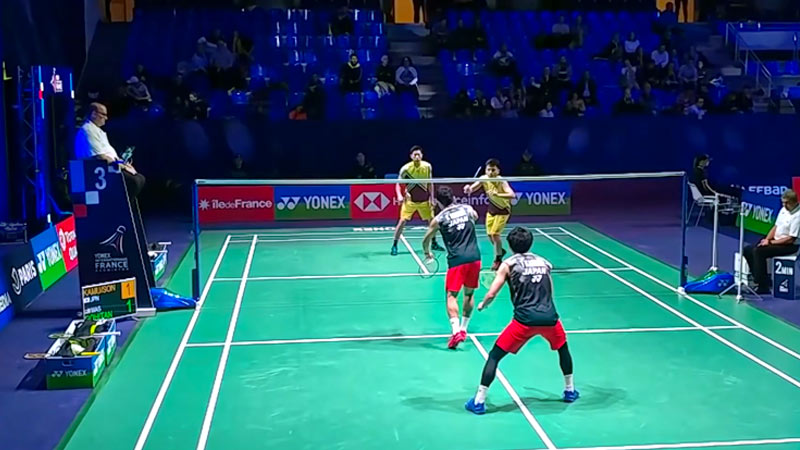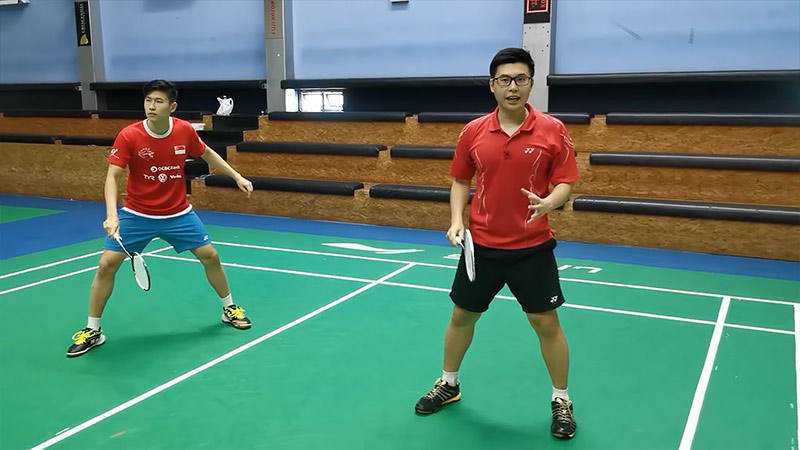The game of badminton, known for its lightning-quick rallies and strategic gameplay, requires a precisely designed court that sets the stage for intense matches.
Whether you’re a casual player or a fervent fan, understanding the dimensions of a badminton court is essential to appreciate the sport’s intricacies.
In this article, we’ll delve into the frequently asked questions about the size of a badminton court for doubles play, shedding light on the specifics that contribute to fair and competitive matches.
What Is the Size Of the Badminton Court For Doubles?
A doubles badminton court measures 20 feet in width and 44 feet in length. The dimensions are marked for both singles and doubles play, but the court is slightly wider for doubles.
The width of 20 feet is divided into two equal halves by the net, and each side is considered a “service court.” The length of 44 feet comprises the entire playing area. A clear space of at least 2 feet should be maintained outside the court’s boundary lines.
The net is positioned at a height of 5 feet in the center and 5 feet, 1 inch at the posts. Proper adherence to these dimensions ensures fair and competitive doubles badminton matches, with ample space for players’ movement and strategic gameplay.
Dimensions of a Standard Badminton Court
A standard badminton court is meticulously designed to accommodate the dynamic gameplay of the sport while ensuring fairness and strategic possibilities.
The dimensions of a badminton court are regulated by the Badminton World Federation (BWF) and are as follows:
Overall Dimensions
The court’s length is 44 feet (13.4 meters), and its width is 20 feet (6.1 meters). These dimensions provide ample space for players to move around and engage in fast-paced rallies.
Singles and Doubles Markings
The same court is used for both singles and doubles matches, with different markings for each. The width remains the same, but for singles, the length is reduced to 17 feet (5.18 meters) wide.
Net Position
The net is positioned at the center of the court, creating two equal halves. It should be suspended at a height of 5 feet (1.524 meters) in the center and 5 feet, 1 inch (1.55 meters) at the posts.
Service Courts
Each side of the net is divided into two service courts by a center line, which is perpendicular to the net. The service courts are further divided into short-service and long-service areas.
Boundary Lines
The court is surrounded by boundary lines that define the playing area. These lines determine if a shuttlecock is considered “in” or “out” during play.
Clear Zone
There should be a clear space of at least 2 feet (0.61 meters) beyond the boundary lines. This ensures that players have sufficient room to move and retrieve shots without obstruction.
Tape or Markings
The court’s boundary lines and other markings are usually made with tape or paint to ensure visibility. The tape should be firmly affixed to the playing surface.
Color Contrast
The color of the court and its lines should provide a clear contrast against the shuttlecock, ensuring better visibility for both players and officials.
Uniformity
The dimensions of the court must be consistent and uniform, maintaining the integrity of the game and providing a level playing field for players.
Safety
Proper court dimensions not only enhance gameplay but also contribute to the safety of the players. Having ample space prevents collisions and accidents during intense rallies.
The dimensions of a standard badminton court are crucial in maintaining the essence of the sport. These specifications ensure that matches are played fairly, strategically, and in an environment that allows players to showcase their skills while adhering to the rules set forth by the governing body.
Importance of Consistent Dimensions

Consistent dimensions in a badminton court are of paramount importance for several reasons:
Fair Play
Uniform court dimensions ensure that all players, regardless of where they are competing, face the same conditions. This fairness is crucial in maintaining the integrity of the game and providing equal opportunities to all participants.
Skill Development
Players practice and develop their skills based on the standard court dimensions. Consistency allows players to fine-tune their techniques, footwork, and strategies, leading to a higher level of competition.
Strategic Play
Players and coaches strategize based on the court’s dimensions. A consistent court allows for predictable bounces and shuttle trajectories, enabling players to execute well-planned tactics and capitalize on opponents’ weaknesses.
Accurate Judgement
Line calls and shuttlecock placements depend on players’ familiarity with court dimensions. Accurate judgments prevent disputes and ensure that the correct calls are made during matches.
Safety
Maintaining standard dimensions reduces the risk of collisions and accidents on the court. Players anticipate shots and positions based on these dimensions, promoting a safer playing environment.
Spectator Experience
Fans and viewers expect to witness matches played under consistent conditions. Predictable court dimensions make it easier for spectators to follow the game and appreciate the players’ skills.
Rule Adherence
The rules of badminton are designed around standard court dimensions. Deviations could lead to rule violations or confusion among players, officials, and spectators.
Global Competition
In international competitions, athletes from various countries come together. Consistent dimensions ensure that athletes from different regions are accustomed to the same playing conditions, fostering fair global competition.
Record Comparability
Consistency in court dimensions allows for an accurate comparison of records and achievements across different tournaments and eras.
Training and Preparation
Players need to prepare both physically and mentally for matches. Familiarity with standard court dimensions enables them to anticipate shots, positions, and movements effectively.
Rule Enforcement
Officials, referees, and judges rely on standardized dimensions to make accurate calls and decisions during matches. Deviations could lead to confusion and controversy.
Consistent dimensions in a badminton court are the foundation upon which the entire sport is built. They ensure fairness, skill development, strategic play, safety, and the smooth functioning of matches at all levels of competition.
Adhering to these dimensions is crucial for upholding the principles of the game and providing an optimal experience for players, officials, and spectators alike.
Strategies and Gameplay on a Doubles Court
Playing doubles badminton requires a unique set of strategies and gameplay tactics compared to singles. Effective communication, coordination, and court positioning are key to success.
Here are some strategies and gameplay aspects specific to doubles badminton:
Court Positioning
Both players should maintain a balanced court coverage. One player covers the front and midcourt (forecourt player), while the other covers the backcourt (backcourt player).
Positioning can switch between players based on the situation, but players must communicate effectively to avoid confusion.
Serve and Return
The server should aim for a low, short serve to create opportunities for their partner to intercept at the net. The returning pair can use aggressive shots to put pressure on the server’s side, making it difficult for them to follow up with a strong third shot.
Net Player’s Role
The net player (forecourt player) aims to intercept shots early, putting pressure on the opponents and preventing them from making effective shots. Quick reflexes, soft touches, and deceptive shots are essential for the net player.
Backcourt Player’s Role
The backcourt player focuses on powerful clears, smashes, and defensive shots to keep the opponents at bay. Creating deep shots can force opponents to hit upwards, providing opportunities for the net player to intercept.
Rotation and Switching
Players need to switch positions strategically to adapt to changing situations and exploit opponents’ weaknesses. Switch after a successful attacking shot or when the opponent is on the defensive to maintain control of the rally.
Communication
Effective communication between partners is vital. Call out shots, signal for switching, and coordinate movements to avoid collisions and ensure optimal positioning.
Attacking Play
Doubles teams often use aggressive attacking play to keep the opponents under pressure. Fast-paced drives smashes, and quick net shots can force opponents into making mistakes.
Defensive Play
Solid defensive skills are important. Lifts and clears should be accurate to prevent opponents from attacking effectively. Quick reactions and good positioning can neutralize opponents’ attacking shots.
Deceptive Shots
Incorporating deceptive shots can catch opponents off guard and create openings for attacking opportunities. Deceptive flick serves, drop shots, and cross-court shots can be effective tactics.
Reading Opponents
Observing opponents’ playing styles and weaknesses is crucial. Exploit their vulnerabilities by directing shots to their weaker side.
Rally Building
Use a combination of shots to build a rally. Mix up shots to keep opponents guessing and create openings for attack.
Teamwork and Trust
Building trust and understanding between partners is essential. Knowing each other’s strengths and tendencies allows for smoother gameplay.
In doubles badminton, effective teamwork, communication, and strategic court positioning are pivotal. The combination of offensive and defensive tactics, along with smart shot selection, can help teams dominate rallies and secure victory against opponents.
Badminton Court Size Chart
Here’s a simple chart illustrating the standard dimensions of a badminton court for both singles and doubles play:
| Aspect | Singles Play | Doubles Play |
| Length | 44 feet | 44 feet |
| Width | 17 feet | 20 feet |
| Net Height (Center) | 5 feet | 5 feet |
| Net Height (Posts) | 5 feet, 1 inch | 5 feet, 1 inch |
| Service Court Length | 22 feet | 22 feet |
| Service Court Width | 17 feet | 20 feet |
| Clear Zone (Beyond Lines) | 2 feet | 2 feet |
Please note that these dimensions are in feet and inches, adhering to the standards set by the Badminton World Federation (BWF). The measurements are approximate and are intended to provide a general overview of the court dimensions for both singles and doubles play.
FAQs
What are the overall dimensions of a badminton court for doubles play?
A standard badminton court for doubles measures 44 feet in length and 20 feet in width. This well-defined space allows players to showcase their agility and strategic prowess while maintaining a level playing field.
Are the court dimensions the same for both singles and doubles play?
No, the dimensions vary between singles and doubles play. For doubles, the court retains the 44 feet length but expands to 20 feet in width. In contrast, for singles, the width narrows to 17 feet, providing a different dynamic for gameplay.
How is the net height regulated in a doubles badminton court?
The net is suspended at a height of 5 feet in the center of the court. At the outer posts, it’s slightly higher at 5 feet, 1 inch. This net positioning facilitates the proper clearance and challenges players to navigate their shots strategically.
What is the significance of the service courts in a doubles court layout?
The service courts are integral components of a doubles badminton court. These areas, divided by the center line and perpendicular to the net, dictate where serves and initial shots are made. A service must land within the opponent’s service court diagonally across the net to be considered legal.
Why is the clear zone beyond the boundary lines important?
A clear zone of at least 2 feet beyond the boundary lines is crucial for players’ safety and mobility. This space ensures that players can move freely, retrieve shots, and maintain their balance without the risk of colliding with walls or obstacles.
Wrapping Up
The dimensions of a badminton court for doubles play are meticulously crafted to enhance the gameplay experience, promote fairness, and encourage strategic maneuvering.
Understanding the specifics of court size, net height, and service court divisions allows players and enthusiasts to grasp the intricacies that shape each intense rally.
As players step onto the court, these dimensions provide the framework for them to engage in dynamic exchanges and exhibit their skills in a competitive and controlled environment.







